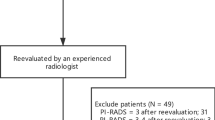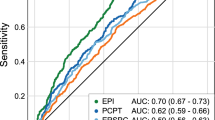Abstract
The aim of this study was to analyse the factors that predict the diagnosis of prostate cancer (PCa) after high-grade prostatic intraepithelial neoplasia (HGPIN). Data from 546 patients with HGPIN submitted up to a 6-month series of three rebiopsies, according to an institutional protocol, were reviewed. PCa has been found in 174 cases (31.8%), in 116 cases at the first and in 58 cases at a further rebiopsy. The risk of finding PCa at the first rebiopsy was correlated with the PSA value and with an anomalous digital rectal examination (DRE) at the time of the initial biopsy; the risk at a subsequent rebiopsy was correlated to the number of cores with HGPIN, with a cutoff of four, and to the ratio with the total number of cores (‘PIN density’), with a cutoff of 50%, at the time of initial biopsy. A tailored protocol of controls can be suggested: (a) higher PSA value and/or anomalous DRE: early extended or saturation rebiopsy; (b) number of cores with HGPIN ⩾4 and/or PIN density ⩾50%: delayed rebiopsy; and (c) no risk factors: PSA and DRE controls.
This is a preview of subscription content, access via your institution
Access options
Subscribe to this journal
Receive 4 print issues and online access
$259.00 per year
only $64.75 per issue
Buy this article
- Purchase on Springer Link
- Instant access to full article PDF
Prices may be subject to local taxes which are calculated during checkout
Similar content being viewed by others
References
Bostwick DG, Montironi R . Prostatic intraepithelial neoplasia and the origins of prostatic carcinoma. Pathol Res Pract 1995; 191: 828–832.
Epstein JI, Potter SR . The pathological interpretation and significance of prostate needle biopsy findings: implications and current controversies. J Urol 2001; 166: 402–410.
McNeal JE . Origin and development of carcinoma in the prostate. Cancer 1969; 23: 24–34.
Bostwick DG, Brawer MK . Prostatic intraepithelial neoplasia and early invasion in prostate cancer. Cancer 1987; 59: 788–794.
Joniau S, Goeman L, Pennings J, Van Poppel H . Prostatic intrapithelial neoplasia (PIN): importance and clinical management. Eur Urol 2005; 48: 379–385.
Sanchez-Chapado M, Olmedilla G, Cabeza M, Donat E, Ruiz A . Prevalence of prostate cancer and prostatic intraepithelial neoplasia in Caucasian Mediterranean males: an autopsy study. Prostate 2003; 54: 238–247.
Epstein JI, Cho KR, Quinn BD . Relationship of severe dysplasia to stage A (incidental) adenocarcinoma of the prostate. Cancer 1990; 65: 2321–2327.
Quinn BD, Cho KR, Epstein JI . Relationship of severe dysplasia to stage B adenocarcinoma of the prostate. Cancer 1990; 65: 2328–2337.
Shin M, Takayama H, Nonomura N, Wakatsuki A, Okuyama A, Aozasa K . Extent and zonal distribution of prostatic intraepithelial neoplasia in patients with prostatic carcinoma in Japan: analysis of whole-mounted prostatectomy specimens. Prostate 2000; 42: 81–87.
Gallo F, Chiono L, Gastaldi E, Venturino E, Giberti C . Prognostic significance of high-grade prostatic intraepithelial neoplasia (HGPIN): risk of prostatic cancer on repeat biopsies. Urology 2008; 72: 628–632.
Epstein JI, Herawi M . Prostate needle biopsies containing prostatic intraepithelial neoplasia or atypical foci suspicious for carcinoma: implications for patient care. J Urol 2006; 175: 820–834.
Chin AI, Dave DS, Rajfer J . Is repeat biopsy for isolated high-grade prostatic intraepithelial neoplasia necessary? Rev Urol 2007; 9: 124–131.
Moore CK, Karikehalli S, Nazeer T, Fisher HA, Kaufman Jr RP, Mian BM . Prognostic significance of high grade prostatic intraepithelial neoplasia and atypical small acinar proliferation in the contemporary era. J Urol 2005; 173: 70–72.
Compos-Fernandes JL, Bastien L, Nicolaiew N, Robert G, Terry S, Vacherot F et al. Prostate cancer detection rate in patients with repeated extended 21-sample needle biopsy. Eur Urol 2009; 53: 600–606.
Herawi M, Kahane H, Cavallo C, Epstein JI . Risk of prostate cancer on first re-biopsy within 1 year following a diagnosis of high grade prostatic intraepithelial neoplasia is related to the number of cores sampled. J Urol 2006; 175: 121–124.
Heidenreich A, Aus G, Bolla M, Joniau S, Matveev VB, Schmid HP et al. EAU guidelines on prostate cancer. Eur Urol 2008; 53: 68–80.
Kronz JD, Allan CH, Shaikh AA, Epstein JI . Predicting cancer following a diagnosis of high grade PIN on needle biopsy. Am J Surg Pathol 2001; 25: 1079–1085.
De Nunzio C, Trucchi A, Miano R, Stoppacciaro A, Fattahi H, Cicione A et al. The number of cores positive for high grade prostatic intraepithelial neoplasia on initial biopsy is associated with prostate cancer on second biopsy. J Urol 2009; 181: 1069–1075.
Roscigno M, Scattoni V, Freschi M, Raber M, Colombo R, Bertini R et al. Monofocal and pluri-focal high-grade prostatic intraepithelial neoplasia on extended prostate biopsies: factors predicting cancer detection on extended repeat biopsy. Urology 2004; 63: 1105–1110.
Akhavan A, Keith JD, Bastacky SI, Cai C, Wang Y, Nelson JB . The proportion of cores with high-grade prostatic intraepithelial neoplasia on extended-pattern needle biopsy is significantly associated with prostate cancer on site-directed repeat biopsy. BJU Int 2007; 99: 765–769.
Naya Y, Ayala AG, Tamboli P, Babaian RJ . Can the number of cores with high-grade prostate intraepithelial neoplasia predict cancer in men who undergo repeat biopsy? Urology 2004; 63: 503–508.
Brimo F, Vollmer RT, Corcos J, Humphrey PA, Bismar TA . Outcome for repeated biopsy of the prostate: roles of serum PSA, small atypical glands, and prostatic intraepithelial neoplasia. Am J Clin Pathol 2007; 128: 648–651.
Merrimen JL, Jones G, Walker D, Leung CS, Kapusta LR, Srigley JR . Multifocal high grade prostatic intraepithelial neoplasia is a significant risk factor for prostatic adenocarcinoma. J Urol 2009; 182: 485–490.
Netto GJ, Epstein JI . Widespread high-grade prostatic intraepithelial neoplasia on prostatic needle biopsy: a significant likelihood of subsequently diagnosed adenocarcinoma. Am J Surg Pathol 2006; 30: 1184–1188.
Montironi R, Mazzucchelli R, Lopez-Beltran A, Cheng L, Scarpelli M . Mechanisms of disease: high-grade prostatic intraepithelial neoplasia and other proposed preneoplastic lesions in the prostate. Nat Clin Pract Urol 2007; 4: 321–332.
Lefkowitz GK, Taneja SS, Brown J, Melamed J, Lepor H . Follow-up interval prostate biopsy 3 years after diagnosis of high grade prostatic intraepithelial neoplasia is associated with high likelihood of prostate cancer, independent of change in prostate specific antigen levels. J Urol 2002; 168: 1415–1418.
Zynger DL, Yang X . High-grade prostatic intrapeithelial neoplasia of the prostate: the precursor lesion of prostate cancer. Int J Clin Exp Pathol 2009; 2: 327–338.
Author information
Authors and Affiliations
Corresponding author
Ethics declarations
Competing interests
The authors declare no conflict of interest.
Rights and permissions
About this article
Cite this article
Antonelli, A., Tardanico, R., Giovanessi, L. et al. Predicting prostate cancer at rebiopsies in patients with high-grade prostatic intraepithelial neoplasia: a study on 546 patients. Prostate Cancer Prostatic Dis 14, 173–176 (2011). https://doi.org/10.1038/pcan.2011.3
Received:
Revised:
Accepted:
Published:
Issue Date:
DOI: https://doi.org/10.1038/pcan.2011.3



